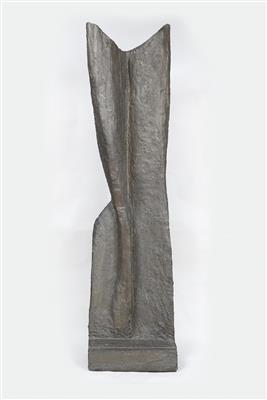Giacinto Cerone *

(Melfi 1957–2004 Rome)
Il Trono, 1989, wood and silvered cement, 193.5 x 50 x 31 cm
Photo certificate:
Archivio Giacinto Cerone, Rome, no.018918
Provenance:
Salon Privé Arti Visive, Rome, there acquired in 1999 by the present owner
Private Collection, Italy
“Sculpture is not a shape, but the result of great internal pressure. We must be the hammers that break the glass, in order to be the wind that enters the houses.”
Giacinto Cerone’s life was brief: born in Melfi in 1957, he died in Rome in 2004, at only forty-seven years old, having lived a life of excess; a life which was also densely packed with work, so much so that he was to leave a profound mark on the sculpture of his time.
Troubled, existential, Cerone’s work always stands apart from the crowd. A poet and intellectual, a sophisticated pianist as well as a sculptor, he was active on the Roman scene in the Eighties, but was always solitary. “I create my own anxiety. Better yet, I theorise it. The basis of my work is the theory of anxiety.”
In 2011 the Galleria Nazionale d’Arte Moderna in Rome dedicated an important retrospective to the artist which united the many forms of his poetics: from the wood of his beginnings, soon to be covered in cement in order to seem less archaic and primaeval, to glazed ceramics, rich with explosions of light: red and green, white and grey and black, to plaster, through to plastic and marble.
Giuseppe Appella described the work of his friend the artist Giacinto Cerone thus: “The impetuosity of Fazzini, the analysis of Boccioni, and the synthesis of Fontana, the meditation of Licini and the spontaneity of Leoncillo, the construction of Melotti and the sensation of Novelli, are all assumed as values which must contribute to the logical articulation of the functional unit of sculpture.”
It is difficult then to rank this work whose primary objective – according to Cerone – was not to be linguistically unambiguous, rigorous, and cohesive, but instead provocatively risky, attempting to divine its own diversity, or better, its uniqueness. Cerone was well-versed in images, and he remembered them as he blended the influences of Brancusi and Martini, Arp and Fazzini, in his work. He was also gripped for some time by more remote influences, from mediaeval Basilicata which he had explored, as Giuseppe Appella remembers, a hundred times, with great zeal, wandering in the land of his birth; an era which in the Basilicata encompassed both the gold and prestige of the Byzantines, and the severity and gauntness of the Romanesque.
27.11.2018 - 18:00
- Realized price: **
-
EUR 12,700.-
- Estimate:
-
EUR 20,000.- to EUR 30,000.-
Giacinto Cerone *
(Melfi 1957–2004 Rome)
Il Trono, 1989, wood and silvered cement, 193.5 x 50 x 31 cm
Photo certificate:
Archivio Giacinto Cerone, Rome, no.018918
Provenance:
Salon Privé Arti Visive, Rome, there acquired in 1999 by the present owner
Private Collection, Italy
“Sculpture is not a shape, but the result of great internal pressure. We must be the hammers that break the glass, in order to be the wind that enters the houses.”
Giacinto Cerone’s life was brief: born in Melfi in 1957, he died in Rome in 2004, at only forty-seven years old, having lived a life of excess; a life which was also densely packed with work, so much so that he was to leave a profound mark on the sculpture of his time.
Troubled, existential, Cerone’s work always stands apart from the crowd. A poet and intellectual, a sophisticated pianist as well as a sculptor, he was active on the Roman scene in the Eighties, but was always solitary. “I create my own anxiety. Better yet, I theorise it. The basis of my work is the theory of anxiety.”
In 2011 the Galleria Nazionale d’Arte Moderna in Rome dedicated an important retrospective to the artist which united the many forms of his poetics: from the wood of his beginnings, soon to be covered in cement in order to seem less archaic and primaeval, to glazed ceramics, rich with explosions of light: red and green, white and grey and black, to plaster, through to plastic and marble.
Giuseppe Appella described the work of his friend the artist Giacinto Cerone thus: “The impetuosity of Fazzini, the analysis of Boccioni, and the synthesis of Fontana, the meditation of Licini and the spontaneity of Leoncillo, the construction of Melotti and the sensation of Novelli, are all assumed as values which must contribute to the logical articulation of the functional unit of sculpture.”
It is difficult then to rank this work whose primary objective – according to Cerone – was not to be linguistically unambiguous, rigorous, and cohesive, but instead provocatively risky, attempting to divine its own diversity, or better, its uniqueness. Cerone was well-versed in images, and he remembered them as he blended the influences of Brancusi and Martini, Arp and Fazzini, in his work. He was also gripped for some time by more remote influences, from mediaeval Basilicata which he had explored, as Giuseppe Appella remembers, a hundred times, with great zeal, wandering in the land of his birth; an era which in the Basilicata encompassed both the gold and prestige of the Byzantines, and the severity and gauntness of the Romanesque.
|
Buyers hotline
Mon.-Fri.: 10.00am - 5.00pm
kundendienst@dorotheum.at +43 1 515 60 200 |
| Auction: | Post-War and Contemporary Art I |
| Auction type: | Saleroom auction |
| Date: | 27.11.2018 - 18:00 |
| Location: | Vienna | Palais Dorotheum |
| Exhibition: | 17.11. - 27.11.2018 |
** Purchase price incl. buyer's premium and VAT
It is not possible to turn in online buying orders anymore. The auction is in preparation or has been executed already.
